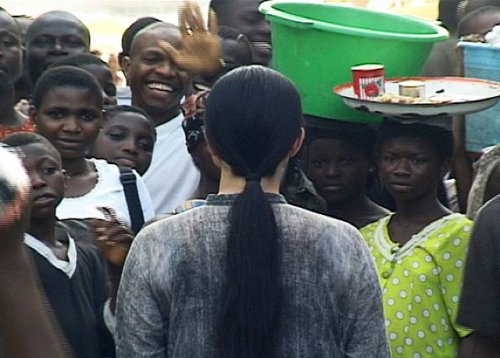Kimsooja
dal 27/1/2005 al 12/3/2005
Segnalato da
27/1/2005
Kimsooja
Kewenig Galerie, Koln
Bottari – Cologne 2005. The artist wraps up used clothes in richly colored traditional Corean bedlinen. The textile of these so called Bottari shows, how deeply rooted Kimsooja is in her Corean tradition, which gives an own meaning to every pattern of the fabric, being closely attached to a lot of ritual traditions and actions in Corea. The Bottari also stress artist's own history, when she packed her bundle to leave her home.

Bottari – Cologne 2005
In the center of the great exhibition hall of the Kewenig Galerie a small Tempo-truck of 1938 is piled up with colorful fabric-bundles by KIMSOOJA. The Corean artists, who lives in New York, is best known in Germany since her single show at the museum kunst palast at Düsseldorf in 2004. She wraps up used clothes in richly colored traditional Corean bedlinen. The textile of these so called Bottari shows, how deeply rooted KIMSOOJA is in her Corean tradition, which gives an own meaning to every pattern of the fabric, being closely attached to a lot of ritual traditions and actions in Corea. The Bottari also stress KIMSOOJA's own history, when she packed her bundle to leave her home. The Bottari Cologne installation, being shown in the Kewenig Galerie reminds of the artist's performance Cities on the Move (1997), when KIMSOOJA drove a truck full of Bottari allover Corea. This work was then also presented during the 1999's Biennale di Venezia. The German truck being shown in Cologne could be historically related to German history with its fugitives' tracks with their poor bundles as a result of the second world war.
In addition of this main work KIMSOOJA presents three Bottari films in the great exhibition hall of the Kewenig Galerie. Since long the artist uses this term not only for the textile bundles but interpretates it as concentration of human experiences and emotions of every single one, personally and in society. In Bottari – Alfa Beach KIMSOOJA presents the surf of a calm sea in front of a deep horizon head first. Like waves also seem hundreds of people in Bottari – Zocalo, the second of the toneless loops. The individual is only a coloured dot and no longer to be identified within the anonymous mass. The Bottari - Thunderstorm shows a nowadays rare picture in times of 24-hours TV presentations and improved transmission techniques – an empty screen evokes the impression of silent snow falling down.
Stills of the performative journey Cities on the Move are exhibited in big light boxes in the basement of the Kewenig Galerie. Their motives concentrate the ideas of KIMSOOJA's, which she expresses in many ways. In her works she stresses how every human being is different and unique and questions what may be his position between the collective and the individual, the global and the local, also in respect of being a woman from her point of view.
In the basement KIMSOOJA shows a clothes-line full of Bottari-fabrics with their rich patterns. Their models symbolize human life, how it goes in these bedlinen between procreation and fertility, death and mortality. Here are the artistic roots of the artist, who started to work with traditional Corean textiles and then, when leaving her home, came to a more abstract artistic language also using digital media.
Graphics, showing the patterns of the Bottari-fabrics, complete the single exhibition of KIMSOOJA at the Kewenig Galerie. They reduce the Bottari to their motives and their meanings.
Opening reception 28 January 2005, 7 – 9 pm
Image: Stil from 'A Neddle Woman – Mexico City, Cairo, Lagos, London', 2000-2001
Kewenig Galerie - Appellhofplatz 21 - Cologne
Opening hours of the gallery: Monday thru Saturday from 10 am to 6 pm



